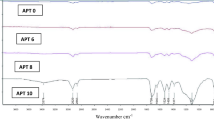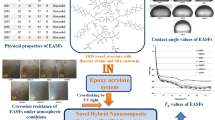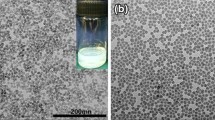Abstract
Polyacrylate (PAE)/nano-silica (SiO2) hybrids were prepared by an in situ sol–gel process of tetraethyl orthosilicate in the presence of PAE toluene solution. The hybrid coatings were fabricated using a PAE/SiO2 suspension by the traditional casting. Their intermolecular interaction and morphology, as well as thermal, mechanical, and optical properties, were investigated using Fourier transform infrared spectroscopy, field-emission scanning electron microscope, differential scanning calorimetry and TG/DTA thermogravimetric analysis, coating impact testing, and UV–Vis spectroscopy, respectively. At the same time, their abrasive properties were carried out by abrasion resistance and nanoindentation tests. The results indicate that silica nanoparticles, with diameter about 30 nm, can disperse homogeneously in the PAE matrix, where hydrogen bonds between the PAE and nano-silica are formed. Therefore, homogeneous dispersion of nano-silica particles provides high transparency for the PAE/SiO2 hybrid coating as the size of nano-silica phase is much smaller than the wavelength (390–770 nm) of visible light. PAE/nano-silica hybrid coatings have increased T g and thermal stability including the onset decomposition temperature, 10 % weight loss temperature, and char at 700 °C. Additionally, the incorporation of nano-silica particles improves the glossiness of the PAE/nano-silica hybrid coatings and enhances their abrasion resistance and surface hardness. The nano-silica content has obvious effect on the thermal, mechanical, optical, and anti-abrasion properties of PAE/SiO2 hybrid coatings. With the consideration of all the properties of hybrid coatings, the PAE/SiO2 hybrid containing 10 phr of nano-silica has the optimal composition. These PAE/nano-silica hybrid coatings have potential applications in high-performance hologram image recording.








Similar content being viewed by others
References
Hariharan P (2002) Basics of holography. Cambridge University, New York, pp 78–82
Zou H, Wu SS, Shen J (2008) Polymer/silica nanocomposites: preparation, characterization, properties, and applications. Chem Rev 108:3893–3957
Sangermano M, Messori M (2010) Scratch resistance enhancement of polymer coatings. Macromol Mater Eng 295:603–612
Lin H, Day DE, Stoffer JO (1992) Optical and mechanical properties of optically transparent poly (methyl methacrylate) composites. Polym Eng Sci 32:344–350
Wen J, Wilkes GL (1996) Organic/inorganic hybrid network materials by the sol-gel approach. Chem Mater 8:1667–1681
Landry CJT, Coltrain BK, Landry MR, Fitzgerald JJ, Long VK (1993) Poly (vinyl acetate)/silica-filled materials: material properties of in situ vs fumed silica particles. Macromolecules 26:3702–3712
Jethmalani JM, Sunkara HB, Ford WT (1997) Optical diffraction from silica-poly (methyl methacrylate) composite films. Langmuir 13:2633–2639
Huang SL, Chin WK, Yang WP (2005) Structural characteristics and properties of silica/poly (2-hydroxyethyl methacrylate) (PHEMA) nanocomposites prepared by mixing colloidal silica or tetraethyloxysilane (TEOS) with PHEMA. Polymer 46:1865–1877
Liao W, Teng H, Qu J, Masuda T (2011) Fabrication of chemically bonded polyacrylate/silica hybrid films with high silicon contents by the sol–gel method. Prog Org Coat 71:376–383
Ma HZ, Hu J, Zhang ZJ (2007) Polyacrylate/silica nanocomposite materials prepared by sol-gel process. Eur Polym J 43:4169–4177
Yang L, Xu Y, Qiu S, Zhang Y (2012) Polyacrylate/SiO2 nanocomposites prepared by combining non-aqueous sol-gel process and mini emulsion polymerization. J Polym Res 19:30–35
Huang ZH, Qiu KY (1997) The effects of interactions on the properties of acrylic polymers/silica hybrid materials prepared by the in situ sol-gel process. Polymer 38:521–526
Wang ZY, Han EH, Ke W (2006) Effect of acrylic polymer and nanocomposite with nano-SiO2 on thermal degradation and fire resistance of APP-DPER-MEL coating. Polym Degrad Stab 91:1937–1947
Wang Y, Li Y, Zhang R, Huang L, He W (2006) Synthesis and characterization of nanosilica/polyacrylate composite latex. Polym Compos 27:282–288
Gao Y, Choudhury NR, Dutta N, Matisons J, Reading M, Delmotte L (2001) Organic-inorganic hybrid from ionomer via sol-gel reaction. Chem Mater 13:3644–3652
Lee LH, Chen WC (2001) High refractive-index thin films prepared from trialkoxysilane-capped poly (methyl methacrylate)-titania materials. Chem Mater 13:1137–1142
Moller K, Bein T, Fischer RX (1998) Entrapment of PMMA polymer strands in micro- and mesoporous materials. Chem Mater 10:1841–1852
Chang CC, Chen WC (2002) Synthesis and optical properties of polyimide-silica hybrid thin films. Chem Mater 14:4242–4248
Menard K (1999) Dynamic mechanical analysis: a practical introduction. CRC, Boca Raton 2
Zheng CF, Chen F, Zhang JJ, Zhou XP, Zeng FD, Xie XL (2010) Laser holographic material based on acrylic resin blend with intermolecular hydrogen bonding. J Funct Mater 41:386–389
Dashtizadeh A, Abdouss M, Mahdavi H, Khorassani M (2011) Acrylic coatings exhibiting improved hardness, solvent resistance and glossiness by using silica nanocomposites. Appl Surf Sci 257:2118–2125
Wu RJ (1998) Surface and interface of polymer. Academic, Beijing, pp 180–240
Xie XL, Tang CY, Chan KL, Wu XC, Tsui CP, Cheung CY (2003) Wear performance of ultrahigh molecular weight polyethylene/quartz composites. Biomaterials 24:1889–1896
Oliver WC, Pharr GM (1992) Improved technique for determining hardness and elastic modulus using load and displacement sensing indentation experiments. J Mater Res 7:1564–1583
Yan WY, Pun CL, Simon GP (2012) Conditions of applying Oliver-Pharr method to the nanoindentation of particles in composites. Compos Sci Technol 72:1147–1152
Moffa JP, Lugassy AA, Guckes AD, Gettleman L (1973) An evaluation of non-precious alloys for use with porcelain veneers. Part I Physical properties. J Prosthet Dent 30:424–431
Acknowledgments
This work was supported by the National Natural Science Foundation of China (51035002, 51273073), and National Basic Research Program of China (973 Program) (2011CB606002).
Author information
Authors and Affiliations
Corresponding author
Rights and permissions
About this article
Cite this article
Zheng, CF., Yang, ZF., Lv, CC. et al. Thermal stability and abrasion resistance of polyacrylate/nano-silica hybrid coatings. Iran Polym J 22, 465–471 (2013). https://doi.org/10.1007/s13726-013-0146-2
Received:
Accepted:
Published:
Issue Date:
DOI: https://doi.org/10.1007/s13726-013-0146-2




